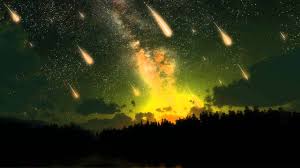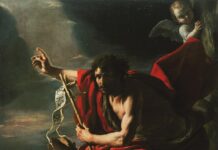As we approach the end of the liturgical year, the readings at Mass once again turn to the end of this world and the second coming of Christ. Jesus says, “But in those days, after that tribulation, the sun will be darkened, and the moon will not give its light, and the stars will be falling from heaven, and the powers in the heavens will be shaken” (Mk. 13:24-25).
Recently, I have listened to a number of talks by an Orthodox icon carver from Quebec named Jonathan Pageau. He grew up Baptist, but through his study of art and traditional symbolism he was led to the Orthodox Church. His talks focus on symbolism in art and culture – classical up to today. He largely draws from Eastern Christian sources, but he also uses examples from Western Christianity and pagan sources. He has clearly spent an admirable amount of time reading Scripture, the Fathers of the Church, the great philosophers, and reflecting on traditional art. I highly recommend checking out his videos and podcast, his art, and the articles he has written for the Orthodox Arts Journal, if you are interested in learning more about symbolism and traditional Christian art.
That unpaid promotion of Jonathan Pageau, though a tangent, was important because his talks have influenced this reflection on the readings for the 33rd Sunday in Ordinary time; namely, that the heavens contain what is most meaningful. It’s a statement that may seem obvious when put that way, but that’s not usually how it is formulated. This theme surfaces in a number of Pageau’s talks, but you could listen to The Metaphysics of Pepe as an example.
First, I need to confess that I am much more of a materialist than I would like to admit. There are two traditional senses of Scripture: literal and spiritual. The spiritual is then subdivided into the moral, allegorical, and anagogical senses (cf. CCC, 109-119). The difficulty is that I and most modern readers don’t know the literal language of the Bible as well as we should. What we know quite well is the literal language of materialism. This disposition toward materialism has resulted in a fifth sense of Scripture: the materialist sense. The materialist sense of Scripture is the ever-present need for the modern reader to give a physical/material meaning to Biblical texts.
I am not saying that the use of symbolic language indicates a lack of historical reality. The Bible does, of course, speak about physical historical realities. My point is that the literal meaning is more than what can be conveyed through a materialist interpretation. We read in Dei Verbum, the Vatican II Constitution on Divine Revelation, “to search out the intention of the sacred writers, attention should be given, among other things, to “literary forms” (Dei Verbum, 12). The paragraph goes on to say that along with understanding the particular genres and circumstances in which a text is written, it is also necessary to read it in harmony with the rest of Scripture, the living tradition of the Church, and in conformity with Magisterial teaching (cf. DV, 12). These rules facilitate our ability to rule out obviously false interpretations of Scripture, but they don’t necessarily bring us to a clear interpretation of the literal sense of every passage in the Bible. When a passage is written in symbolic language, we must know the language of the symbolic in order to know the literal sense.
A simple and important example is the creation narrative. The materialist sense is that the text is describing God’s six day recipe for constructing a universe and on the seventh day He rests. I am confident that’s not right, and the Catechism seems to agree: “Scripture presents the work of the Creator symbolically as a succession of six days of divine “work”, concluded by the “rest” of the seventh day” (CCC, 337). The language is symbolic, but what does it mean? The serpent is the devil, but why is the devil a serpent? The garden is paradise, but why is paradise a garden? Adam and Eve are real people and they really did sin, but there is so much more to the story than the materialist narrative grasps.
Now, keeping those questions in mind, how do we read Christ’s words from Mark 13: 24-25? The whole chapter is written in symbolic language, but I am only going to focus on these two verses to make my point. There is far too much symbolism in this chapter to unpack in one article. Jesus says, “But in those days, after that tribulation, the sun will be darkened, and the moon will not give its light, and the stars will be falling from heaven, and the powers in the heavens will be shaken” (Mk. 13:24-25). If we were to read these words as a materialist, then we might assume the literal meaning to be a declaration by Christ that before He comes again there is going to be some sort of celestial event, perhaps a natural or man-made disaster, that will darken the sky. Maybe there will be a series of asteroids that strike the earth, which produces a cloud of dust that eclipses the sun and moon. Or maybe there will be a nuclear war? Hundreds of nuclear bombs falling from the sky could be called stars falling from heaven, and the subsequent nuclear winter would darken the sun and moon. Maybe those things will happen, but are they the literal meaning that Christ intends to convey to His listeners?
What if we were to read sun, moon, and stars as symbolizing what is most meaningful and darkness as symbolic of death? Then the heavens are symbolic of containing what is most meaningful – what is most meaningful in itself or what is most meaningful to us – and darkness is the death of what is most meaningful. Because they symbolize both what is most meaningful in itself and what is most meaningful to us, the verses can be interpreted on multiple levels while still remaining in the literal sense. The symbolic nature also means that the spiritual senses can be present within the words of the text in a way that is not merely the reader imposing metaphor onto the text but is literally present within the language of the symbolic.
We’ll start with the individual. If what is most meaningful to me is pleasure, then maybe sex is the sun, maybe food and drink are the moon and TV shows, movies, and video games are my stars. What if these were taken from me by illness or injury and I could no longer have them? My sky is darkened; the stars are falling. This is what the symbols mean at the level of the individual. There is clearly a moral sense to this interpretation: the destruction of our false idols will leave us in darkness.
We can look at it at the level of a city. If a city is built around its banks, investment, credit and insurance companies, then those are what are most meaningful. If money is a city’s sun, moon, and stars, what happens if the economy totally collapses and all of those companies disappear? The sky is darkened; the stars are falling.
Jesus clearly expects His immediate audience, the Jews, to understand Him at least at this level because it answers their question about the destruction of the temple. The Temple was the centre of Jewish life. It was constructed as a microcosm of the universe, and it was the dwelling place of God. The destruction of the Temple, which took place a few decades after Christ ascended into heaven, was the end of the old Jewish world. They entered into darkness.
Finally, we can look at the symbolism on a universal level. What is most meaningful in itself? God is the sun. He is present to us through His Church and the Sacraments. Mary is the moon. The saints and sacred institutions such as marriage and the family, and life itself are the stars. Christianity and Christian civilization are built on these being what are most meaningful. In the modern era, however, many people began to turn away from the traditional Christian heritage. The shift began prior to the Protestant revolt, but the Reformation played a major role in the undoing of Christian civilization. The Eucharist, the priesthood, confession, Mary, the saints, and many aspects of Christian life were abandoned by the Reformers. Then, in the Enlightenment, the personal, self-revealing God of Christianity was abandoned for the deist vision of a clockmaker, who made the universe initially but does not interact with it anymore. By the end of the 19th century western civilization had reached the point at which Nietzsche was able to confidently write, “God is dead. God remains dead. And we have killed him” (Nietzsche, The Gay Science).
When Nietzsche wrote those famous words in 1882 there were many people who really believed him and were trying to live as though God didn’t exist. On a national level Communism is the paramount example of God being dead. Everywhere that the Soviet flag flew the government sought to remove God and replace Him with their own ideology.
The Soviet Union didn’t conquer the world, but the atheistic neo-marxist ideology has continued to spread, and the sky has gotten darker. We live in a society that no longer acts as though God exists. This is what Pope St. John Paul II referred to as “practical atheism”. Many still profess God’s existence, but how many live as though He is the sun? Even within the Church, which should be steadfast in holding onto what is truly meaningful, many are in darkness. The Church hierarchy is in crisis because many priests and bishops have committed grave sins such as sodomy, paedophilia, heresy, adultery and theft. Priests and bishops have largely lost the trust of the people. The Sacrament of Holy Matrimony is being abandoned. Few are seeking it and it seems that many in the Church have even stopped believing in the reality of the Sacrament as a lifelong covenant symbolizing God’s own covenant with us. Life is no longer seen as sacred. Through the sin of contraception our society shows that it fears new life. We are so afraid of new life that if contraception fails, many are willing to kill children in their mother’s womb. There are roughly 100 000 abortions each year in Canada alone. There isn’t much left of significant meaning in our society. The sky is pretty dark.
However, it is at this point of total darkness, when God has died, that we are prepared for the resurrection. In Mark 13 Jesus is also speaking both about His approaching crucifixion and His second coming at the end of the world. At the time of His crucifixion the sun went dark. Nature mirrored the deeper reality that God had died, and in that darkness His disciples awaited the fulfilment of His promise to rise again. Two thousand years ago He kept His promise, and He will keep His promise at the end of the world. Jesus says, “And then they will see the Son of man coming in clouds with great power and glory” (Mk 13:26). In order to rise, we must first die. Before Christ comes again, we must enter a time of great darkness. This happens on an individual level when our personal idols are destroyed, we repent, and Christ’s grace enters our soul through the Sacraments – He comes to us “in clouds with great power and glory” as He returns to His rightful place as our sun. It also happens on a communal level when a group’s idols are destroyed, they repent, and then place what is truly most meaningful back at the centre of the community. On a global level we seem to be in the final stages of a process of cultural death, so what happens next? Darkness and resurrection.
What do we do? Stay focused on the true sun, moon, and stars! Do not let them be darkened in your sky. Look at the sanctuary of the Church. The saints and angels are there. Scripture and Tradition are there. The Sacraments are there. Keep your eyes fixed on the Eucharist. It’s no accident that the Host is round and is raised for all to see. It’s no accident that the chalice is gold and shines above the altar. There is the Son.











